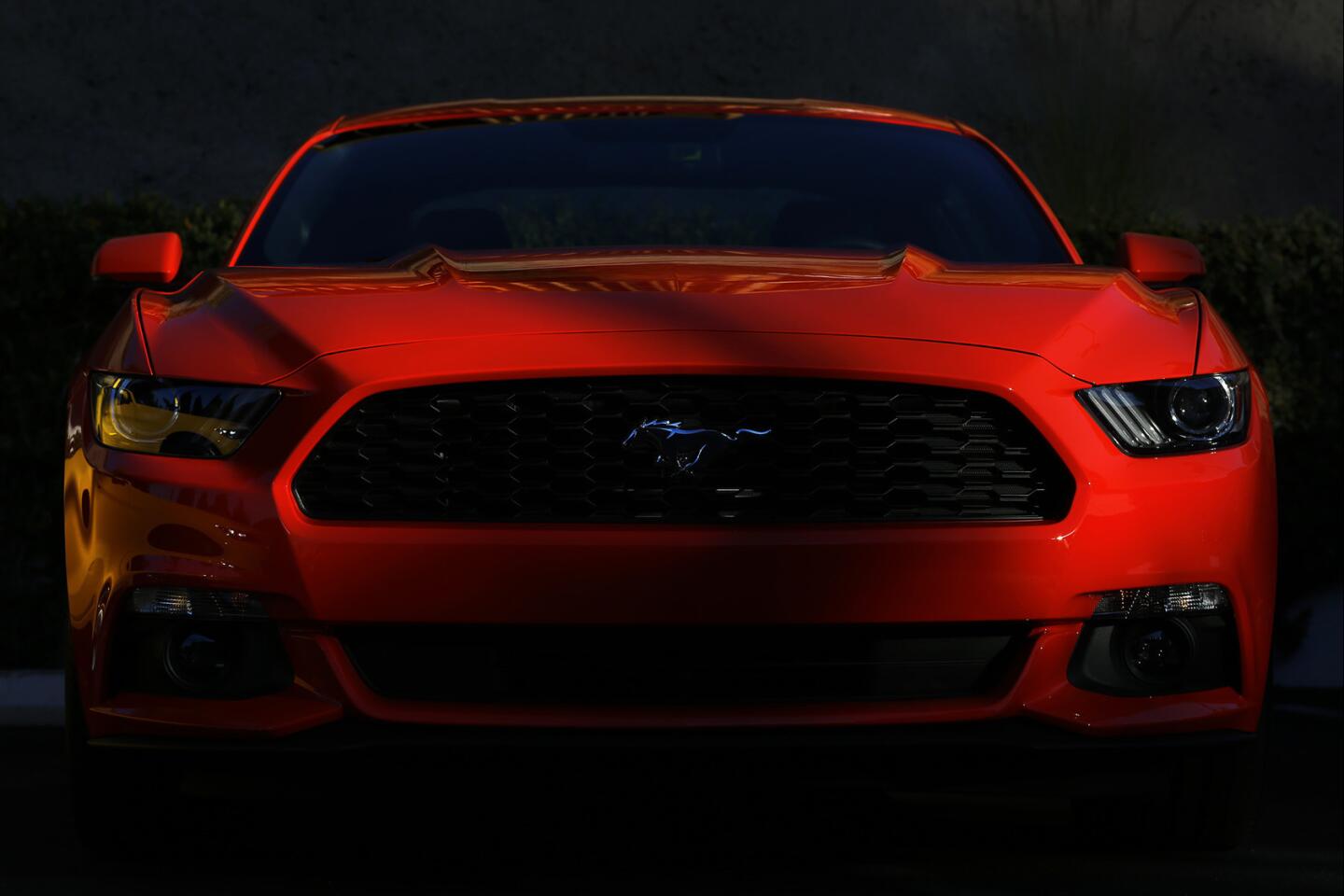2013 Mustang GT: Does retro have a future?
- Share via
A decade ago, as Ford engineers prepared the next-generation Mustang, they stared down an inescapable truth: The best Mustangs were built in the 1960s.
So they set out to build a brand-new 1968 Mustang fastback, wrapping modern technology in retro sheet metal. That strategy carried its own risks, like asking the Rolling Stones to rerecord “Exile on Main Street.”
It’s clear now that it worked brilliantly, setting off an unlikely second coming of the muscle car era. In a familiar stampede, Chevrolet and Dodge — which scrambled in the ‘60s to make their own “pony cars” — followed Ford’s lead again with refried versions of the original Camaro and Challenger.
Photos: Mustangs through the years
The 2013 Mustang GT we tested recently, a drag-strip beast that could smoke most anything from the ‘60s, may be among the last of the retro breed. With the Mustang’s 50th anniversary approaching next year, the engineers in Dearborn, Mich., are again feverishly designing the next-generation Mustang. They face an even tougher challenge: How do you take a car into the future after you’ve taken it a half-century into the past?
However wonderful the next Mustang may be, it will be a shame to see this one pass into history, whence it came. The successful remake of the 1967-68 car represents a kind of redemption for dumb decisions Ford made when it abandoned the early Mustangs in the first place, leading to a series of putrid pony cars throughout the 1970s. (Note to Ford: DO NOT bring back the Mustang II.)
A week in the old-school cockpit of the latest GT confirms that its ride, handling and shifting are an upgrade over both ancient and recent Mustangs, which have always been a bit crude — endearingly so.
Ford has also pulled off a subtle but substantial evolution of its retro design. A mid-cycle refresh in 2010 added a sharpened belt line and a rear end pinched in on both sides. For 2013, Ford added a more prominent front grille and other tweaks. The updates somehow made the car look simultaneously less dated and more like the old car.
But only one option really matters on this car: the 302-cubic-inch, 5.0-liter V-8, a direct descendant of the first 302 small-block introduced in the 1968 Mustang, now with a ludicrous 420 horsepower and 390 pound-feet of torque. The first retro Mustang GT, a 2005 model, was impressive enough with 300 horses. Piling on 120 more is like deep-frying bacon in pork fat.
With the optional six-speed manual, it’s difficult to launch the GT without roasting enough rubber to set off neighborhood smoke alarms. Shifts into second gear provoke another loud bark from the rear tires. Pushing the 7,000-rpm redline in higher gears requires acres of open highway.
The car’s least-expected quality is a near-optimal trade-off between aggressive handling and a comfortable ride, both of which came in handy on the twisty, pockmarked Pasadena Freeway.
The GT has its issues. All Mustangs do. Their point has never been perfection, but rather the proper ratio of performance to price. The car can be a handful to drive in town, and feels a tad too big and heavy. Its center console is awkwardly angled up toward the back seat, making manual shifting an elbow-bumping affair.
Proper flogging of the GT also exposes a drawback to the whole ‘60s motif. The retro thing extends to the tall, skinny numbers on the circular analog speedometer. They’re cool but hard to read, especially in the split second you have to look down, past your white knuckles, as the horizon starts to blur.
The GT dispenses with zero to 60 mph in 4.3 seconds on its way to 12.7-second quarter mile, according to Motor Trend. If you want something just a hair faster, plunk down $190,000 on an Aston Martin DB9.
Our loaded test car came to $40,255, a bit high for the quintessential affordable fast car. But GTs start at $31,545, and the V-6 base model — with a more-than-respectable 305 horsepower — brings the price down to $22,995.
All this sets a high bar for the next-generation Mustang. If Ford has learned anything from history, it will take care to avoid repeating what happened after the 1960s, a textbook case of messing with success. The first Mustang, a 1965 model unveiled on April 17, 1964, at the New York World’s Fair, lasted just two model years — even though Ford sold more than a million of the cars. Feeling competitive pressure from Chevy and Dodge, the automaker rushed out two more generations before 1970. They were larger, faster cars, but respectful of the original.
Then Ford drove the Mustang into a ditch. The stretched and bloated 1971 Mustang, stripped of its trademark side-panel scoops, was a misguided attempt to turn the pony car into a luxury coupe. By 1973, as new emissions standards and an oil crisis took hold, horsepower had plummeted to a measly 150 for the strongest available V-8, according to a history of the Mustang by auto information company Edmunds.com.
That mere mistake was compounded by the crime against transportation known as the Mustang II, sold from the 1974 to 1978 model years. The mini-Mustang, which shared a chassis and engines with the lowly Pinto, today ranks second on Edmunds.com’s list of 100 all-time worst cars.
The Mustang didn’t fully recover until 1985, when Ford finally dropped a respectable version of its 5.0-liter V-8 into the long-running sixth-generation pony car. Horsepower topped 200 for the first time since 1971, and the “five-point-oh” models proved quite popular. (Today’s GT gives a nod to this era with a small “5.0” badge just behind the front-wheel hub.)
The history no doubt weighs heavily on Mustang engineers now holed up in top-secret design sessions, walking the line between traditional and innovation. Whatever emerges will be the product of much pride and many arguments, says Jim Owens, a marketing manager for the Shelby line of ultra-performance Mustangs.
“There’s a billboard on the plant that builds Mustangs. It says, ‘We love taking our work home with us,’” Owens said, describing the factory in Flat Rock, Mich. “We will argue over a single pound of tire pressure and what it means at the apex of Turn 11 at Laguna Seca.”
The speculation is well underway. Some auto critics are predicting independent rear suspension, even turbocharging, which might smack of sacrilege to purists. Best-guess renderings of the next body style are all over the Internet. Some suggest a measured evolution, some a bold departure.
“They’re probably going to move it past the retro design, but without abandoning the classic silhouette that’s been part of every successful Mustang since 1964 — a long hood and a short rear deck,” said Scott Oldham, vice president of editorial at Edmunds.com. “You can make a modern car and still make it classic and timeless. That’s the challenge ahead of Ford.”
You can also take a classic car and make it modern, as the current Mustang has proved. Our advice to Ford: The Mustang is finally back in a good place. Don’t screw it up. Don’t get any big ideas. Do what you should have done in the 1970s: Let the shape of the car change slowly, organically, over many years. Treat it like Porsche treats the 911.
You want to put a tiny turbocharged engine in it? Fine, if you must. Just keep a V-8 option. We need time to process these things. Independent rear suspension? Whatever. Just don’t run up the price. Forget traction control — we know how to drive. Don’t over-worry about fuel economy. And, whatever you do, keep it rear-wheel drive — forever.
It’s a Mustang. Let it be what it is. It’s been 50 years now. It’s our car, not yours.
ALSO:
Photos: Mustangs through the years
Photos: Seven generations of Corvettes
Rapid Review: Chevy Camaro ZL1







